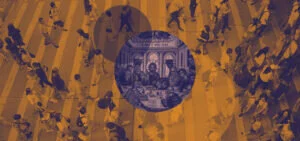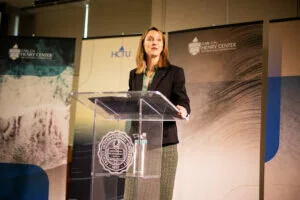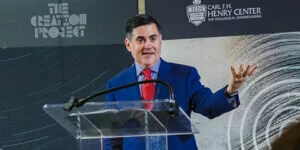It is difficult to talk about human beings without telling a story. In a manner that transcends the existence of trees and turtles, human beings are creatures of history. Human beings come and go in history. They make history by the feats they accomplish, and they leave their mark on history in the monuments they build and the children they produce. Human beings are creatures of history with a story to be told.
What is true of human beings in general is true of human origins as well. It is difficult to talk about human origins without telling a story. Contemporary evolutionary science tells a story of “common descent.” According to this account, an original population of 10,000 human beings, existing in the anatomical form with which we are familiar today (Homo sapiens), emerged around 200,000 years ago in Africa through an often-vicious process of natural selection from hominin ancestors held in common with apes. Thus told, the story of contemporary evolutionary science knows of no original pair of human beings from whom the entire human race descends. It knows of no historical fall from a state of innocence.
The Bible also tells a story of human origins. According to this account, God created all things very good, including an original pair of human beings, Adam and Eve, from whom all other human beings descend by means of ordinary generation. Though created in a state of innocence, these two human beings rebelled against God by transgressing his commandment, bringing on themselves and their progeny God’s punishment for sin in the sentence of death. Death, however, does not have the last word in the Bible’s story of human beings. In addition to its story of humankind’s creation and fall, the Bible also tells the story of God’s work to redeem and glorify human beings through the incarnation, death, resurrection, ascension, enthronement, and second coming of his beloved Son, our Lord Jesus Christ, the second Adam. For this reason, the Apostle Paul summarizes the entire storyline of Scripture as a tale of two Adams: “as in Adam all die, so also in Christ shall all be made alive” (1 Cor 15:22).
Two Books, One Author
In Chapter Six of Reformed Theology & Evolutionary Theory, Gijsbert van den Brink engages these two distinct accounts of human origins. The fundamental question he addresses is: What if the evolutionary story of human origins is true? (p. 165).
Van den Brink’s engagement is not driven by a quest for “concordism,” the creative but ultimately unsatisfying attempt to find a one-to-one correspondence between the details of the biblical story and the details of the evolutionary story (pp. 178, 195). He is driven by principles native to Reformed theology.
In Article 2 of the Belgic Confession, Reformed Christians confess that both the Book of Nature and the Book of Scripture have something to teach us about human beings. Moreover, because these two books share one divine author, when they are rightly interpreted, the Book of Nature and the Book of Scripture will agree (pp. 22–31, 94). Due to human finitude and fallenness, a conflict of interpretations always remains a possibility and, when our interpretation of the Book of Nature seems to contradict the Book of Scripture, Reformed theology defers to the Book of Scripture, not only because it is the supreme source and norm for our knowledge of God and all things in relation to God, but also because it is the more eloquent of the two books that God has given us. As Abraham Kuyper reminds us, roses do not speak; God in Holy Scripture does. However, as van den Brink rightly observes, a conflict between our interpretation of the Book of Nature and our interpretation the Book of Scripture may also signal to us that we have misinterpreted the Book of Scripture. In such cases, a conflict of interpretations provides an “occasion” for returning to the biblical text to determine where our interpretation of Scripture may have gone astray and how it might be righted (pp. 94, 179).A conflict between our interpretation of the Book of Nature and our interpretation the Book of Scripture may also signal to us that we have misinterpreted the Book of Scripture.
Van den Brink believes that contemporary evolutionary science provides just such an occasion for reconsidering the biblical story of human origins. According to van den Brink, while accepting the evolutionary story of human origins requires us to “recontextualize” the Bible’s story of human origins, it does not commit us to “telling a different story from the one we find in the Bible” (p. 202).Van den Brink draws the language of “telling a different story” from C. John Collins, Did Adam and Eve Really Exist? (Wheaton, IL: Crossway, 2011), 48 (Reformed Theology, 201).
In van den Brink’s “recontextualized” telling of the story of human origins, Adam and Eve no longer play the role of first biological parents to the entire human race. Such a role cannot be sustained in light of contemporary evolutionary science and its story of common descent. Adam and Eve stand instead as federal representatives of the first population of human beings that became aware of God and began to live in covenant relationship with God “around 45,000 years ago” (pp. 176–78, 189–90). Following John Stott, van den Brink calls this population of human beings, Homo divinus. According to van den Brink, at some point in time after the emergence of Homo divinus, Adam and Eve introduced sin into the world through “a first act of willful disobedience to God’s voice” (p. 183). This first act of willful disobedience brought about the human race’s historical transition from its original state of innocence to its current state of sin and death (pp. 193–99). In van den Brink’s recontextualized version of the biblical story of human origins, Adam and Eve thus retain their status as historical figures (as opposed to being timeless paradigms of “Everyman” and “Everywoman”). And the fall retains its status as an historical event (as opposed to belonging to the essential to the fabric of creation as such). Affirming the fall’s status as an historical event is especially important, van den Brink argues, because it simultaneously guards the metaphysical goodness of God’s creation and explains the necessity of God’s saving intervention in history (pp. 181, 185).
Van den Brink’s account is among the more sober recent attempts to engage the biblical story of the creation and fall of human beings with the evolutionary story of human origins. This is due, in part, to the author’s modest approach of “accepting” rather than “embracing” the claims of contemporary evolutionary science (pp. 3–7). It is also due to the author’s masterful grasp of the contours and themes of Reformed systematic theology, which enables him to weigh the various costs that evolutionary science may or may not ask Christian faith to pay in terms of doctrinal revisions. The important critical question, of course, is whether van den Brink succeeds in “recontextualizing” the biblical story of Adam and Eve without “telling a different story from the one we find in the Bible.”
The Main Characters
Van den Brink’s account of the creation and fall of human beings preserves the main characters of the biblical story of human origins (Adam, Eve). It also preserves the overarching sequence of events that is essential to the biblical story line (creation, fall, redemption, consummation). I worry, however, that van den Brink’s account compromises something essential to the logic of the biblical story, namely, the basis of our common humanity.On the topic of “story logic” more broadly, see David Herman, Story Logic: Problems and Possibilities of Narrative (Lincoln, NE: University of Nebraska Press, 2002); Luc Herman and Bart Vervaeck, “Ideology,” in David Herman, ed., The Cambridge Companion to Narrative (Cambridge: Cambridge University Press, 2007), ch. 15.
In Scripture, the descent of the entire human race from Adam and Eve is offered not only as an explanation of human origins but also as an explanation of what binds us together as a human family. As God’s creatures reproduce “each according to its kind” (Gen 1:11, 12, 21, 24, 25, 28), so the image of God—that which distinguishes human beings from all other creatures—is transmitted through the process of ordinary generation from Adam to his offspring (Gen 5:3). Scripture traces the descent of all nations from Adam (Genesis 5; 10; 11:10-32), including Israel (Gen 11:27–32; 1 Chr 1–9), and ultimately identifies Adam as the ancestor of Jesus Christ (Luke 3:23–38), our kinsman-redeemer par excellence. Scripture, moreover, presents the separation of Adam’s offspring as a temporary providential measure, ordered to the coming of the Messiah and the reuniting of all the families of the earth under his redemptive Lordship (Deut 2:5, 9, 12, 19; 32:8–9; Acts 17:26-31; Rev 5:9–10).
In Scripture, the descent of the entire human race from Adam and Eve is offered not only as an explanation of human origins but also as an explanation of what binds us together as a human family.Herman Bavinck regards the unity of the human race as a matter “of the utmost importance” for “religion and morality.” According to Bavinck, the unity of the human race grounds “the solidarity of the human race, original sin,In his classic treatment of original sin, The Imputation of Adam’s Sin (Grand Rapids, MI: Eerdmans, 1959), John Murray rightly connects Adam’s status as federal head of the human race to Adam’s status as biological father of the human race. Without this connection, covenant theology’s tie to the realities of nature is made more arbitrary. the atonement in Christ, the universality of the kingdom of God, the catholicity of the church, and the love of neighbor.”Herman Bavinck, Reformed Dogmatics (Grand Rapids, MI: Baker Academic, 2004), 2:526. According to the universal testimony of Scripture, the unity of the human race finds its basis in our common descent from Adam and Eve.The grounding of our common human nature in our common human descent from Adam and Eve is an expression of God’s ordained power (potentia ordinata) not God’s absolute power (potentia absoluta). Should God will to do so, he is able to raise up human offspring from stones (Matt 3:9).
The unity of the human race is important to van den Brink as well. He judges the “monophyletic” account of human origins (which affirms that “the various human races ultimately stem from one and the same population”) superior to the “polyphyletic” account (which affirms that “humans emerged from various hominin populations at different geographical locations”) and concludes from this judgment that “we are all one big family” (pp. 163–64). I remain unconvinced that a monophyletic account of human origins is sufficient metaphysical ballast to account for our common human nature. The distinction between monophyletic and polyphyletic accounts is only relative and, at the end of the day, the theory of common descent upon which both accounts depend may prove too much. Common descent doesn’t tie human beings together, metaphysically speaking, any more than it does human beings, turtles, and trees. But “surely it is not angels that he helps”—or turtles or trees, “but he helps the offspring of Abraham” (Heb 2:16).Of course, the redemption of human beings entails universal effects for all creation (Rom 8:19–21).
A Modest Thought Experiment
Van den Brink no doubt would ask: What, then, of the conclusions of evolutionary science? Must the Reformed theologian bury his head in the sand? Not at all! The Reformed theologian should encourage evolutionary science to continue its study. He should continue to listen to and learn from evolutionary science. He can ponder and puzzle over its conclusions and, if he has the proper training, he can ask questions of his own about those conclusions. But, as Augustine asserted long ago, the Christian is not required to accept any of the various conclusions of the physikoi which, as we all can attest, change from one generation to the next.Augustine, The Enchiridion on Faith, Hope, and Charity, 9 in The Works of Saint Augustine: A Translation for the 21st Century I/8: On Christian Belief (Hyde Park: New City Press, 2005), 277–78. Nor is he required by Christian faith to revise what he believes to be the clear teaching of Holy Scripture and the confession of his church regarding human origins. To his credit, van den Brink does not ask us to engage in doctrinal revision, but offers his proposal as a thought experiment, and a modest one at that.
The modesty of van den Brink’s overall approach is itself a healthy reminder that not every contradiction between contemporary science and Christianity needs to be taken as an assault on the faith. When it comes to evolutionary science, our data is incomplete. The models we use to analyze our data may be flawed. The rose does not speak! Nor does it tell us how we may improve our analysis! But God in Scripture does speak. And in that divine speech we may rest, even as our quest for scientific understanding of human origins continues, as it must, until the end of the age.








Comments
Be the first one to make a comment!